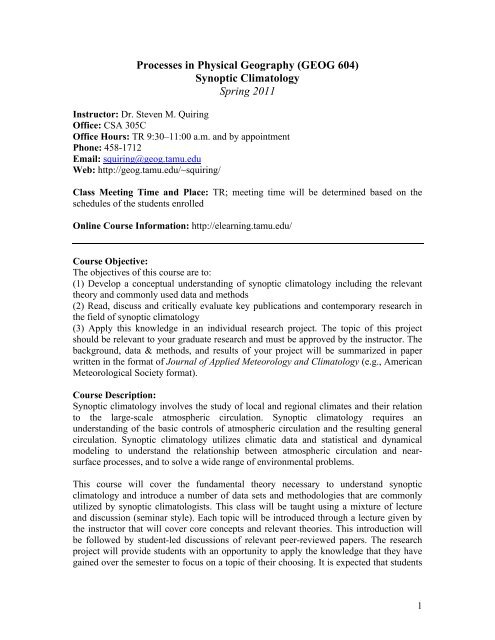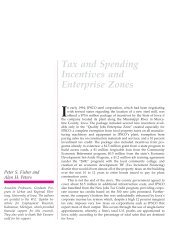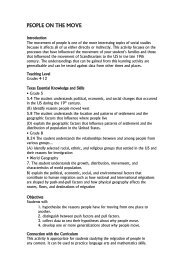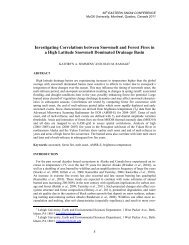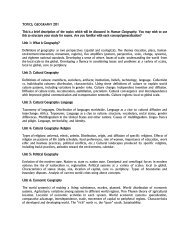Course Syllabus - Department of Geography - Texas A&M University
Course Syllabus - Department of Geography - Texas A&M University
Course Syllabus - Department of Geography - Texas A&M University
Create successful ePaper yourself
Turn your PDF publications into a flip-book with our unique Google optimized e-Paper software.
Processes in Physical <strong>Geography</strong> (GEOG 604)<br />
Synoptic Climatology<br />
Spring 2011<br />
Instructor: Dr. Steven M. Quiring<br />
Office: CSA 305C<br />
Office Hours: TR 9:30–11:00 a.m. and by appointment<br />
Phone: 458-1712<br />
Email: squiring@geog.tamu.edu<br />
Web: http://geog.tamu.edu/~squiring/<br />
Class Meeting Time and Place: TR; meeting time will be determined based on the<br />
schedules <strong>of</strong> the students enrolled<br />
Online <strong>Course</strong> Information: http://elearning.tamu.edu/<br />
<strong>Course</strong> Objective:<br />
The objectives <strong>of</strong> this course are to:<br />
(1) Develop a conceptual understanding <strong>of</strong> synoptic climatology including the relevant<br />
theory and commonly used data and methods<br />
(2) Read, discuss and critically evaluate key publications and contemporary research in<br />
the field <strong>of</strong> synoptic climatology<br />
(3) Apply this knowledge in an individual research project. The topic <strong>of</strong> this project<br />
should be relevant to your graduate research and must be approved by the instructor. The<br />
background, data & methods, and results <strong>of</strong> your project will be summarized in paper<br />
written in the format <strong>of</strong> Journal <strong>of</strong> Applied Meteorology and Climatology (e.g., American<br />
Meteorological Society format).<br />
<strong>Course</strong> Description:<br />
Synoptic climatology involves the study <strong>of</strong> local and regional climates and their relation<br />
to the large-scale atmospheric circulation. Synoptic climatology requires an<br />
understanding <strong>of</strong> the basic controls <strong>of</strong> atmospheric circulation and the resulting general<br />
circulation. Synoptic climatology utilizes climatic data and statistical and dynamical<br />
modeling to understand the relationship between atmospheric circulation and nearsurface<br />
processes, and to solve a wide range <strong>of</strong> environmental problems.<br />
This course will cover the fundamental theory necessary to understand synoptic<br />
climatology and introduce a number <strong>of</strong> data sets and methodologies that are commonly<br />
utilized by synoptic climatologists. This class will be taught using a mixture <strong>of</strong> lecture<br />
and discussion (seminar style). Each topic will be introduced through a lecture given by<br />
the instructor that will cover core concepts and relevant theories. This introduction will<br />
be followed by student-led discussions <strong>of</strong> relevant peer-reviewed papers. The research<br />
project will provide students with an opportunity to apply the knowledge that they have<br />
gained over the semester to focus on a topic <strong>of</strong> their choosing. It is expected that students<br />
1
will have a basic understanding <strong>of</strong> climatology (such as GEOG 324) and statistics (such<br />
as GEOG 652) prior to taking this class.<br />
Learning Objectives:<br />
As a result <strong>of</strong> taking this course you should know (knowledge objectives) and be able to<br />
do certain things (skill objectives).<br />
Knowledge objectives (Things you should know by the end <strong>of</strong> the course):<br />
• Define climatology and synoptic climatology and discuss its role in climate<br />
science<br />
• Summarize the current state <strong>of</strong> knowledge about synoptic climatology and<br />
selected sub-components there<strong>of</strong><br />
• Critique published research on synoptic climatology and be able to describe the<br />
strengths and weaknesses <strong>of</strong> the data and methodology utilized by the authors<br />
• Describe the limitations and biases <strong>of</strong> commonly used climatic data sets (e.g.,<br />
station data, reanalysis data)<br />
• Describe the strengths and weaknesses <strong>of</strong> commonly used synoptic methods (e.g.,<br />
weather typing, subjective & objective classifications, composites, self organized<br />
maps)<br />
Skill objectives (Things you should be able to do by the end <strong>of</strong> the course):<br />
• Interpret formulas, graphs, tables, and schematics, and draw inferences from them<br />
• Locate and analyze climate data sources (including NCDC climate division and<br />
station data, NCEP/NCAR renanalysis data, TRMM precipitation (or other<br />
satellite data), paleoclimate data (e.g., IODP, tree rings), GCM data from IPCC<br />
AR4 models, and teleconnection data)<br />
• Create graphics (line graphs, pie graphs, box plots, etc.) that effectively<br />
communicate information and support your arguments<br />
• Represent climate information symbolically, visually, numerically, and verbally<br />
• Import, summarize, and analyze climate data<br />
• Calculate and interpret statistics<br />
• Analyze variability and trends in climate data<br />
• Develop synoptic classifications and explain the results<br />
• Analyze climate data using a variety <strong>of</strong> tools/methods (for example: scientific<br />
programming, statistical methods (regression, multiple regression (including stepwise),<br />
data reduction (PCA, EOF), model evaluation and cross validation,<br />
compositing, clustering and self-organized maps, time series analysis, CCA,<br />
trend, bootstrapping and Monte Carlo simulation), and modeling (statistical<br />
models, dynamical models)<br />
• Perform library research<br />
• Write a literature review (synthesis <strong>of</strong> the literature)<br />
• Critically evaluate the published research<br />
• Pro<strong>of</strong>-read and edit your own work<br />
• Critically evaluate your own writing and the writing <strong>of</strong> your peers<br />
2
• Write a scientific research paper that conforms to the accepted standard for<br />
publication in a peer-reviewed journal<br />
• Deliver clear and concise oral presentations<br />
<strong>Course</strong> Outline:<br />
Tentative schedule <strong>of</strong> topics to be covered (subject to change).<br />
Part I: What is synoptic climatology? January 18 and January 20<br />
Part II: Global climate and the general circulation January 25 to February 17<br />
Basic controls <strong>of</strong> atmospheric circulation; global circulation; jetstreams; planetary waves;<br />
zonal flow and zonal index; blocking flow and blocking mechanisms; low-frequency<br />
circulation variability and persistence; global teleconnections<br />
Part III: Synoptic systems February 22 to March 3<br />
Climatology <strong>of</strong> cyclones and anticyclones; development <strong>of</strong> cyclones; storm tracks<br />
Part IV: Synoptic climatology: methods March 8 to April 7<br />
synoptic pattern classification (airmasses and circulation); subjective/manual<br />
classification; objective/automated classification<br />
Part V: Synoptic climatology: applications April 12 to April 26<br />
Droughts and floods; air quality; human health; wildfire activity; other topics will be<br />
selected based on the interests <strong>of</strong> the students<br />
Part VI: Student presentations April 28<br />
Grading:<br />
Participation: class discussions and paper presentations 30%<br />
Exams (2 x 15%; March 31 and May TBD) 30%<br />
Project presentation (April 28) 10%<br />
Research Paper (Tuesday, May 3) 30%<br />
The grading system follows the <strong>Texas</strong> A&M <strong>University</strong> grading system:<br />
A = Excellent<br />
B = Good<br />
C = Satisfactory<br />
D = Passing<br />
F = Failing<br />
Grades will be assigned based on the following cut<strong>of</strong>fs: A = > 90%, B = 80-89%, C = 70-<br />
79%, D = 60-69%, F =
(1) Article reviews (10%)<br />
(2) Paper presentations (10%)<br />
(3) Class discussions (10%)<br />
(1) Article reviews: Students are expected to pay detailed, close and critical attention to<br />
readings. For each class meeting, all students will read the assigned material and bring to<br />
class a summary with critique notes and discussion questions in response to the readings<br />
(up to about one page). These exercises will be turned in as part <strong>of</strong> the participation<br />
grade, and they will enable informed in-class discussion.<br />
(2) Paper presentations: Each student will be responsible for presenting and leading a<br />
number <strong>of</strong> discussions on the papers that are covered in class. The schedule will be<br />
arranged in consultation with the instructor. The student leader(s) for each discussion will<br />
give a short presentation summarizing the article(s) and lead the subsequent discussion.<br />
Lead students are expected to obtain and read additional articles where appropriate and<br />
synthesize all the relevant information in their presentation and discussion. Students are<br />
required to prepare formal presentations following the guidelines that will be discussed in<br />
class.<br />
(3) Class discussions: True participation during each class meeting, as well as diligence<br />
on assignments and readings before and after each class, are essential. Simply attending<br />
class and/or attempting to participate by making ad-hoc comments will result in a low<br />
participation grade, as will poor or incomplete weekly assignments.<br />
Exams (30%):<br />
There will be two exams in this course. A mid-term exam worth 15% <strong>of</strong> your final grade<br />
(March 31) and a final exam worth 15% <strong>of</strong> your final grade. The final exam will be held<br />
during during the final exam period in May at a date and time to be determined. The<br />
exams will be essay-based exams and will require students to synthesize the material<br />
covered in readings, discussions and lectures. The final exam is not cumulative (it only<br />
examines the content covered since the mid-term exam).<br />
Research Paper (30%):<br />
The research paper will summarize the background, data & methods, and results <strong>of</strong> your<br />
project will be summarized in paper written in the format <strong>of</strong> Journal <strong>of</strong> Applied<br />
Meteorology and Climatology (e.g., American Meteorological Society format). The topic<br />
<strong>of</strong> the research paper will be selected by the student in consultation with the instructor.<br />
The paper should be approximately 15 double-spaced pages excluding references, figures<br />
and tables. Papers are due on Tuesday, May 3.<br />
Research Presentation (10%):<br />
Each student will be required to give an AMS-style presentation <strong>of</strong> their results on April<br />
28. Each presentation will be 10 minutes with 5 minutes for questions at the end. A<br />
presentation rubric will be handed out in class.<br />
Required textbook: none<br />
4
Required readings: The required readings for this class will be assigned by the pr<strong>of</strong>essor<br />
on a weekly basis. These readings will be drawn from peer-reviewed articles in<br />
climatology, atmospheric science and geography journals.<br />
Excused Absences<br />
This class will follow the <strong>University</strong>’s policy for excused absences. For more information, please see<br />
Section 7 <strong>of</strong> the student rules: http://student-rules.tamu.edu<br />
Scholastic Dishonesty<br />
It is my hope that academic dishonesty will not be a problem in this class. <strong>Texas</strong> A&M does, however,<br />
have a Scholastic Dishonesty policy to which both students and faculty must comply. If you have any<br />
questions about the <strong>University</strong>’s Scholastic Dishonesty policy please review the Student Rules or see me.<br />
The Aggie Honor program is the new program that will handle all cases <strong>of</strong> academic dishonesty. The Aggie<br />
Honor program website is located at http://www.tamu.edu/aggiehonor<br />
The materials used in this course are copyrighted. These materials include but are not limited to syllabi,<br />
quizzes, exams, lab problems, in-class materials, review sheets, and additional problem sets. Because these<br />
materials are copyrighted, you do not have the right to copy the handouts, unless permission is expressly<br />
granted.<br />
As commonly defined, plagiarism consists <strong>of</strong> passing <strong>of</strong>f as one’s own the ideas, words, writings, etc.,<br />
which belong to another. In accordance with this definition, you are committing plagiarism if you copy the<br />
work <strong>of</strong> another person and turn it in as your own, even is you should have the permission <strong>of</strong> that person.<br />
Plagiarism is one <strong>of</strong> the worst academic sins, for the plagiarist destroys the trust among colleagues without<br />
which research cannot be safely communicated.<br />
If you have any questions regarding plagiarism, please consult the latest issue <strong>of</strong> the <strong>Texas</strong> A&M<br />
<strong>University</strong> Student Rules, http://student-rules.tamu.edu, under the section “Scholastic Dishonesty.”<br />
Aggie Code <strong>of</strong> Honor: “An Aggie does not lie, cheat, or steal or tolerate those who do”<br />
http://www.tamu.edu/aggiehonor/<br />
Student Support<br />
The Americans with Disabilities Act (ADA) is a federal anti-discrimination statute that provides<br />
comprehensive civil rights protection for persons with disabilities. Among other things, this legislation<br />
requires that all students with disabilities be guaranteed a learning environment that provides for<br />
reasonable accommodation <strong>of</strong> their disabilities. If you believe you have a disability requiring an<br />
accommodation, please contact the <strong>Department</strong> <strong>of</strong> Student Life, Services for Students with Disabilities in<br />
Room B118 <strong>of</strong> Cain Hall. The phone number is 845-1637.<br />
Services for Students with Disabilities<br />
Room B118 <strong>of</strong> Cain Hall, 845-1637, http://studentlife.tamu.edu/ssd/<br />
There are numerous other student support organizations on campus including:<br />
Center for Academic Excellence and Academic Assistance Clearinghouse<br />
525 Blocker, 845-2724, http://www.tamu.edu/cae<br />
Student Counseling Service<br />
Henderson Hall, 845-4427, http://www.scs.tamu.edu/<br />
5


